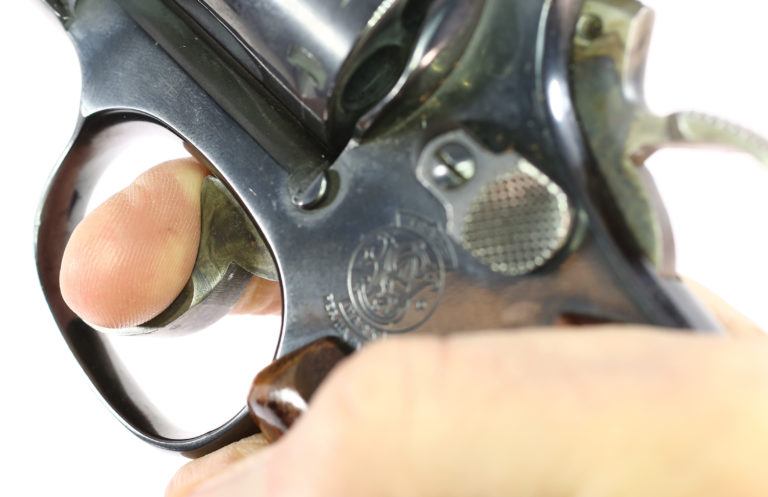
Working the trigger of a double-action revolver quickly and accurately isn’t rocket science, but there is a learning curve.
How to manage a double-action revolver trigger pull:
- Grip the double-action revolver high as possible on the frame.
- Trigger on your trigger finger's first joint.
- If you trigger cock, refine your aim upon cocking and break the shot.
- If not, continue to press smoothly through while keeping the sights on the target.
- Either technique, keep the front sight buried in the target.
You don’t shoot a double-action revolver the same way you shoot a pistol. The lining up the sights, following through and not flinching — that’s all the same. But revolvers require a bit more work in the steps leading up to that. Shooting single-action is no big deal: Thumb-cock the action, aim and press. Double action? That’s different.

First, we need to be on common ground, knowing how a double-action revolver works. When you press the trigger, this happens in the following sequence of events:
The trigger starts by depressing the cylinder lock. This allows the cylinder to move as the trigger progresses. With the cylinder lock down, the hand — that part that moves in a slot in the recoil shield —begins lifting, and the tip of it contacts the rear of the cylinder. The area it contacts is the ratchet, which is a part of the extractor star. The tip of the hand presses up on one of the teeth of the ratchet, and this begins the rotation of the cylinder.
The hand lifts the cylinder until the next charge hole has come in line with the barrel. This is called carry-up. Before the cylinder has finished rotating to carry-up, the trigger releases the cylinder lock. It snaps back up, ready to drop into the next slot in line. The early release of the lock is what causes the “drag line” around the cylinder. The drag line is a cosmetic problem unless the trigger is releasing the lock so soon that you can’t advance the cylinder.
When the cylinder lock is dropping into the next lock slot, the hand has to stop lifting the cylinder. If the ratchet is not correctly timed, the action binds just as you get to the end. This is bad for accuracy. Typically, on a well-fitted revolver, the hand slips off the tooth of the ratchet but presses it from the side, making the lockup tight.
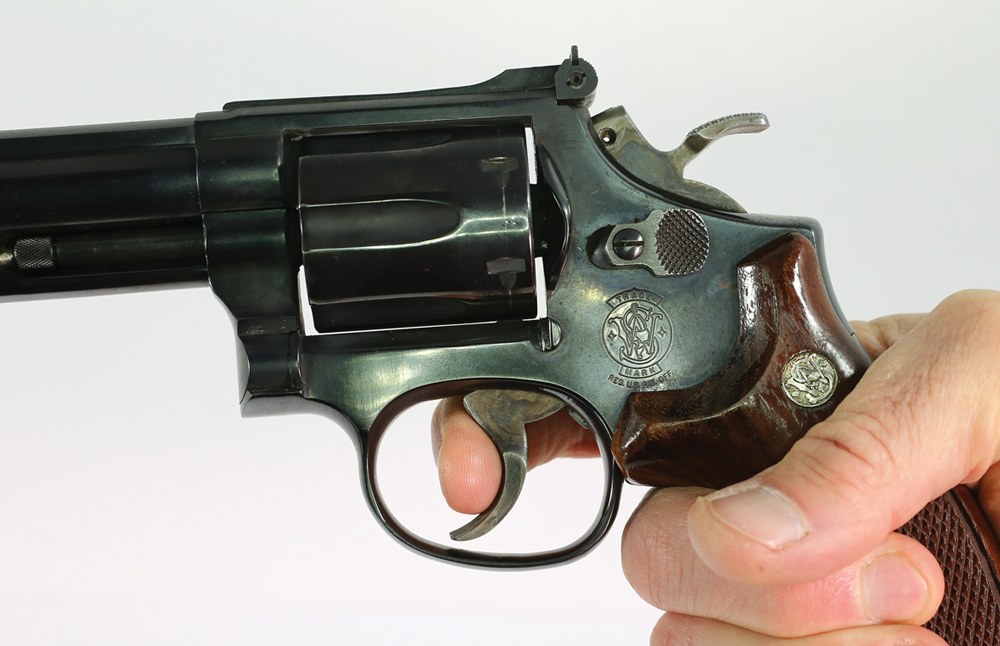
You can see this with an empty revolver. If you dry-fire it (it’s safe, except with rimfires) and hold the trigger back, and then try to wiggle the cylinder, you will notice it’s tight. Let go of the trigger and the cylinder has some play to it.
Revolvers are timed one of two ways. One is “staged” and the other isn’t. In an action that’s built staged, you can trigger-cock the action and stop to aim with the hammer back. You can, with practice, trigger-cock the action through the entire cylinder and never drop the hammer as if firing. Once staged, there’s still a small amount of extra trigger press needed to fire the revolver. An action that’s not staged will drop the hammer as soon as the cylinder lock drops into place.
Why do you want either? A staged action allows you to trigger-cock, then refine your aim, and fire the shot. For revolvers that were not built staged, we would attach a compressible stop behind the trigger or a shelf on the grips. For faster shooting, staging is nice, but it’s not needed.
Now, all of this happens independently of the springs inside the action. It’s possible for an action to “stack,” which is the trigger force needed to complete the operation, increasing near the end. The old Colt revolvers with a “V” spring in the action stacked. But now, with everything using coil springs, stacking is more likely caused by a very small binding in the ratchet/hand fit at the end of the stroke.
Making It Happen
Let’s get to how you operate the mechanism. First, there’s the grip. You want your hand as high on the frame as you can get it. My hand gets so high on some revolvers that when the hammer comes back on double-action, the spur touches my hand. The axis of the bore is higher on a revolver than on a pistol, and you want to take away as much of that leverage as you possibly can.
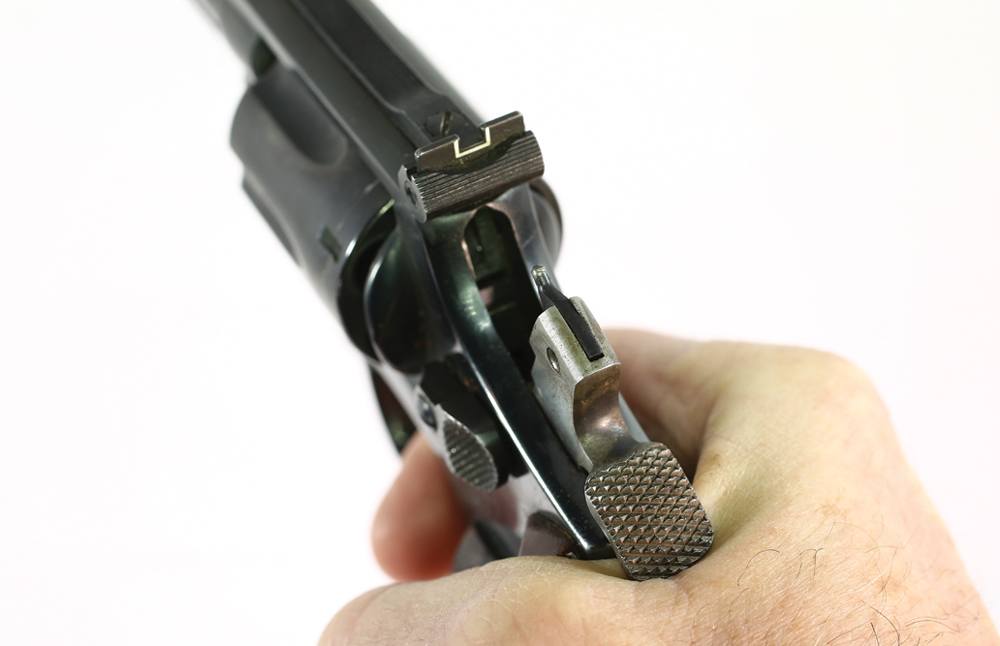
Your trigger finger must rest on the trigger, not on the tip or pad, but on the first joint. The tip or the pad is fine for pistols, but you will be moving the trigger a significant distance. You can’t do that with just the tip of your finger. You also can’t do a short re-set of the trigger. It’s currently en vogue to let the trigger forward on a pistol only as far as needed to let the mechanism rest. On a revolver, that’s a sure way to make yourself crazy. When you push your finger forward to re-set the trigger, do it with as much enthusiasm as you do the press.
Next, you have to decide what kind of shooter you are. Are you going to trigger-cock the action, refine the aim and then break the shot? Or do you want to be faster than that, which will require a different approach?
Either way, you’re going to benefit from the great advantage that the double-action revolver offers you: cheap practice through dry-firing. You have your empty revolver, you have the safe location and you have targets. First, get your grip. Aim. Now press the trigger back slowly — smoothly — in a single motion. While you do this, keep the sights aligned on the target.
Don’t Stop. If the sights wobble off the target, keep pressing and get them back on target. Keep them lined up properly, don’t lunge, and don’t jerk. The only time you stop is if you have a staged revolver and you want to shoot that way. Then you press through smoothly until it stages, then refine, and continue the press until the hammer falls.
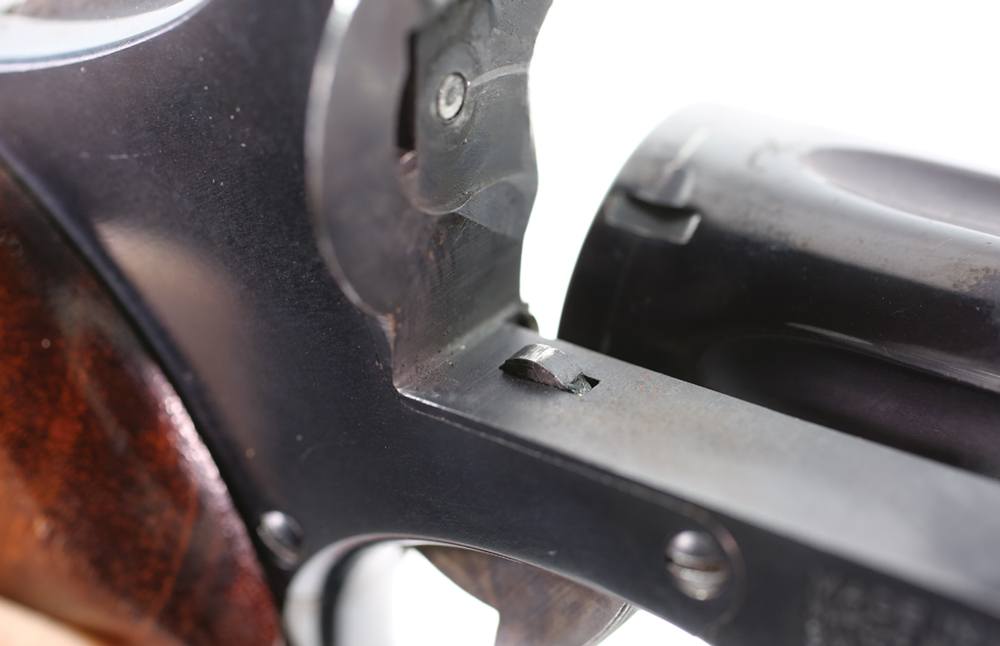
“But, that isn’t fast, and double-action shooting has to be fast,” you say.
This is not instant gratification. This is building skills. You’re teaching your brain to keep the sights aligned while your trigger finger works the action. At first, 10 minutes will do. As you build hand strength, add time and pick up the pace. Once you’ve done this for a while, and you can keep the sights on the target, add a different skill-building exercise.
Start the next sessions without aiming, just point at the floor, and dry-fire your revolver 10 times as fast as you can. Then do your normal work. You’ll notice an increase in your trigger speed while still keeping the sights on the target. Once you start this, every time you begin your dry-fire practice, do this and build speed.
You can, at any time, go to the range and verify your skill-building. Ideally, you’ll use a steel target, and take paint with you. Paint the target a uniform color, and then shoot a small group in the center, slow-fire or single action. Use that as your aiming point, and begin the double-action revolver work. For live-fire work, start from low ready. Bring the revolver up, and start the trigger stroke as soon as the sights get near your cluster of hits. Aim, stroke, recover and repeat.

If your hits start to wander, you’re doing one of three things wrong: One, you’re looking at the target. Watch the front sight. Two, you’re shooting too fast — slow down. Three, you’re getting tired. Take a break.
Once you have a groove, do the same thing with your live-fire practice that you did with the dry-fire. Only you aim this time. To start your practice, get to a range where you can be close to the backstop. Load up, and from low ready, come up on a spot on the hill and shoot all six rounds, double action, just as quickly as you can and stay reasonably close to the aiming point.
The progression of your skills works like this: First, you teach your brain to aim and press the trigger while still aiming. Then, you add very fast double-action to that dry-fire skill. Next, you learn to aim and trigger-press, with real recoil, while staying in a reasonably tight group. Finally, you teach your brain to see the sights at high speed, and to work the trigger quickly.
This is all brain work. If you think of it simply as muscle memory and building up hand and finger strength, you’re missing the point. You aim by seeing, and your brain does the computing to correct aim. You want to build mental skills, not just physical skills.
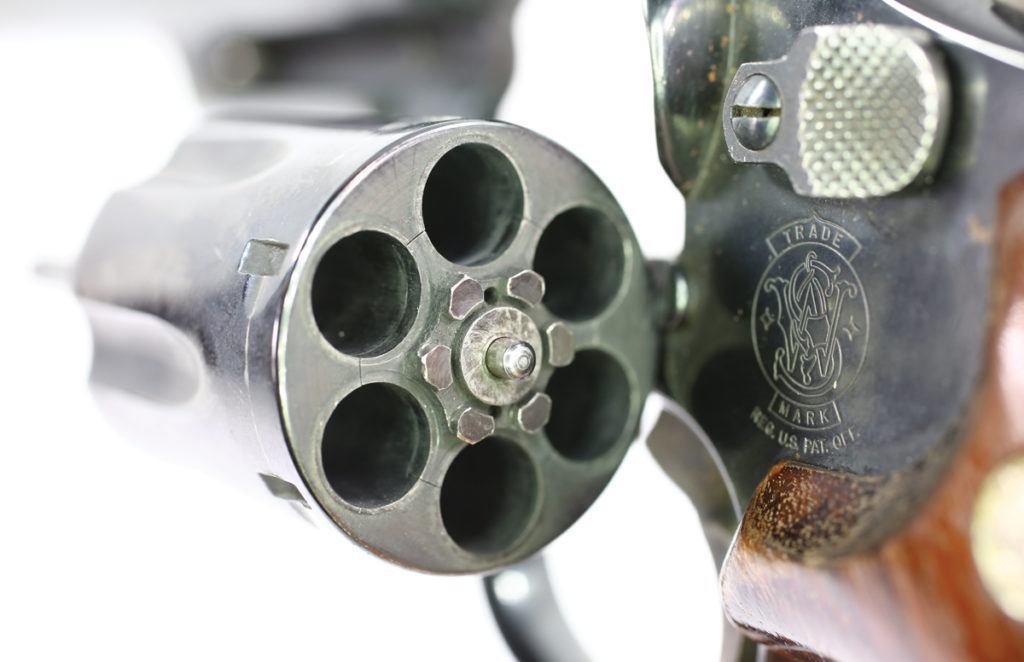
And what of the staging, or not staging? Generally, you have to pick one. If you’re going to shoot very small groups in double-action, you will have to learn to stage. If you want to shoot fast and accurately, you have to learn straight-through trigger pressing. To take a more difficult shot, you simply press through more slowly.
In short, just learn to keep the front sight buried in the middle of your target, while you smoothly, cleanly, quickly, press the trigger all the way through.
This article originally appeared in the 2018 Shooter's Guide issue of Gun Digest the Magazine.

Next Step: Get your FREE Printable Target Pack
Enhance your shooting precision with our 62 MOA Targets, perfect for rifles and handguns. Crafted in collaboration with Storm Tactical for accuracy and versatility.
Subscribe to the Gun Digest email newsletter and get your downloadable target pack sent straight to your inbox. Stay updated with the latest firearms info in the industry.

![Best Concealed Carry Guns In 2025 [Field Tested] Wilson Combat EDC X9S 1](https://gundigest.com/wp-content/uploads/Wilson-Combat-EDC-X9S-1-324x160.jpg)


![Best 9mm Carbine: Affordable PCCs [Tested] Ruger Carbine Shooting](https://gundigest.com/wp-content/uploads/Ruger-Carbine-Shooting-100x70.jpg)
![Best AR-15: Top Options Available Today [Field Tested] Harrington and Richardson PSA XM177E2 feature](https://gundigest.com/wp-content/uploads/Harrington-and-Richardson-PSA-XM177E2-feature-100x70.jpg)
